More than half of people with Gorlin syndrome experience these symptoms and signs.
Epidermal cysts
Also called sebaceous, keratin or epithelial, epidermal cysts are small hard lumps that live just under the skin. Usually slow growing, epidermal cysts can appear anywhere on the body and rarely cause pain or other symptoms unless they become infected or drain.
Some epidermal cysts of the skin require no treatment. Others may need to be surgically removed. Plastic surgeons, dermatologists, and general surgeons do this type of procedure. If the epidermal cysts become infected, medical treatment may be necessary.
Enlarged occipitofrontal circumference
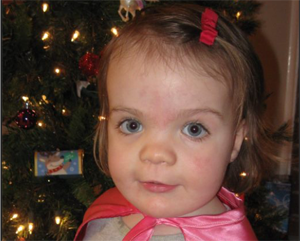
An example of macrocephaly in a young child.
Many people with Gorlin syndrome have large skulls (macrocephaly) and prominent foreheads (frontoparietal bossing). Most people with macrocephaly and frontoparietal bossing will experience no negative health effects. Others may require surgical intervention to correct the development, formation and fusion of the bones of the skull.
Infants, toddlers, and young children should have their head size monitored by their pediatrician. The provider will monitor the sutures (spaces between the skull bones) for proper growth and development.
Brain ventricle asymmetry
Brain ventricles are fluid-filled chambers inside the head that keeps the brain cushioned and protected. When there is more fluid in one chamber than another, the brain ventricle is defined as asymmetric.
Some people with brain ventricle asymmetry experience no symptoms. Others may have mental health issues or problems with speech, movement and cognition.
A neurologist or neurosurgeon can diagnose and manage brain ventricle asymmetry. Mild brain ventricle asymmetry may resolve on its own and therefore needing no treatment, while more severe cases may require a shunt to reduce the amount of fluid.
Calcified falx cerebri
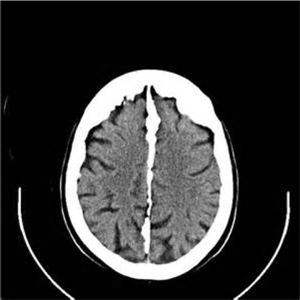
An scan showing a brain with a calcified falx cerebri.
The falx cerebri is a tough membrane that separates the right and left sides of the brain.
The falx cerebri becomes calcified when calcium salts build up and cause the membrane to harden. Calcified falx cerebri is seen in children and adults with Gorlin syndrome and is very common.
A health care provider can identify calcified falx cerebri in an x-ray or brain scan. A calcified falx cerebri has no symptoms and does not affect health.
Ovarian Fibromas
Ovarian fibromas are non-cancerous tumor-like growths on or near a woman’s ovaries. They are made up of an overgrowth of connective tissues. In women with Gorlin syndrome, ovarian fibromas most often appear on both of the ovaries at the same time.
Up to 30% of women with Gorlin syndrome are affected by ovarian fibromas. With proper monitoring and treatment, there is no evidence that suggests ovarian fibromas affect a woman’s fertility.
Ovarian fibromas usually do not cause any problems unless they are large.
Females with Gorlin syndrome should be monitored regularly for ovarian fibromas starting in their early teen years. Ovarian fibromas are detected using imaging such as MRI, CT scan or ultrasound of the lower abdomen.
If the ovarian fibroma is large and/or causing internal issues, surgical removal may be necessary.
Hamartomas (pseudocystic lytic lesions of bones)
A hamartoma is a benign (not cancerous) tumour-like growth in a bone. Hamartomas are made up of cells and tissues that grow abnormally.
Hamartomas generally do not cause problems. However, if a hamartoma develops in the foot, it is important to consult an orthopedic physician. Treatments may include casting and surgery.
High-arched palate
A high-arched palate or high-vaulted palate is where the roof of the mouth is high and narrow. About 30% of U.S. children are born with a high-arched palate. Children with a high-arched palate may have trouble feeding as infants, difficulty breathing, sleep issues, speech problems and difficulty clearing nasal congestion.
People with a high-arched palate should be evaluated by a maxilla-facial surgeon or an otolaryngologist (ear, nose, and throat physician). Treatment for high-arched palate include the use of a tongue expander and exercises to reposition and strengthen the tongue. In more severe cases, surgery may be necessary.
Hyperpneumatization of the paranasal sinuses
Paranasal sinuses are the pockets or cavities of air in the bones of the skull around the nose and in the forehead. The role of the sinuses are many including helping to condition the air we breathe and increasing the sound of our speech.
Hyperpneumatization of the paranasal sinuses means that there is extra air-space in the sinuses around the nose. Generally, there are no symptoms or problems related to this symptom and no treatment is required.
Lumbarization of the sacrum
Lumbarization of the sacrum is when the vertebrae of the sacrum (the large, triangle-shaped bone at the bottom of the spine) appear on x-ray like the lumbar (the spine in the abdominal area) vertebrae. The sacrum of an individual with lumbarization is not as fused as the normal sacrum.
Lumbarization of the sacrum is treated by an orthopedic surgeon or neurosurgeon. Treatments include non-steroidal, anti-inflammatory (NSAIDs) and pain medications and physical therapy. Surgery to correct the defect may be required if more conservative therapy does not help.
Kyphoscoliosis
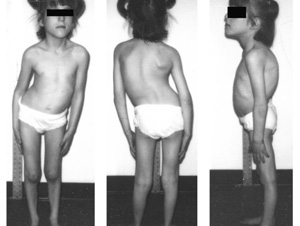
Kyphoscoliosis is when the spine turns both outward and to the side. Image credit: https://commons.wikimedia.org
Kyphoscoliosis is a combination of kyphosis (when the spine turns outward) and scoliosis (when the spine curves into a “c” or “s” shape). In addition to disfigurement, kyphoscoliosis can cause pain, trouble breathing, stiffness fatigue and nerve issues.
People with kyphoscoliosis are treated by an orthopedic surgeon or a neurosurgeon if symptoms are bothersome. Treatments usually begins with physical therapy and back braces. In severe cases surgery may be necessary.
Narrow sloping shoulders
Narrow sloping shoulders are when the shoulders appear to be smaller than the hips and angle downward from the neck. Sloping shoulders generally do not have any symptoms but if they cause discomfort or limit motion, the person should be evaluated by an orthopedic surgeon.
Pectus excavatum or carinatum

Pectus excavatum causes the chest to appear sunken.
Pectus excavatum happens when the sternum (breastbone) and rib cage grow abnormally, causing sunken or caved in appearance of the chest.
Pectus carinatum happens when the breastbone and rib cage develop in a manner that causes the chest to jut out similar to a bird. Because of this, pectus carinatum is sometimes called “pigeon chest.”
Many people with pectus excavatum or carinatum experience no other symptoms related to these conditions. Sometimes these conditions can cause breathing problems, heart issues and pain in the chest and back.
Prognathism

Prognathism causes the lower jaw to stick out further than the upper jaw.
Prognathism is the position of the upper jaw in relation to the lower jaw. In mandibular (lower jaw) prognathism, the lower jaw protrudes or sticks out further from the upper jaw (maxilla). Prognathism of the maxilla means the upper jaw protrudes out further than the lower.
This problem can lead to misalignment of the upper and lower teeth. People with prognathism should be evaluated by their dentist, and possibly an orthodontist and oral surgeon.
Rib anomalies
People with Gorlin syndrome may have a variety of changes in the shape of their ribs. These include ribs that are splayed (turned outward), fused (stuck together), bifid (split in two at the end), and partially missing.
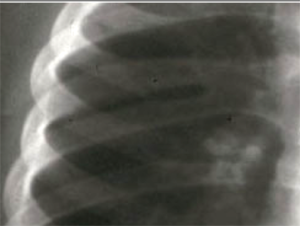
People with Gorlin syndrome may have abnormal shaped ribs
Rib anomalies generally do not cause any symptoms and therefore do not require any treatment.
Short fourth metacarpal
The metacarpal bone is the lower part of the ring finger (the fourth finger counting from the thumb). Some people with Gorlin syndrome have a shorter metacarpal bone than average. Generally, this change in the length of the bone does not cause any problems for the individual.
Spina bifida occulta
In spina bifida occulta, or closed spina bifida, one or more bones of the spine do not form correctly. People with Gorlin syndrome typically have spina bifida occulta in the bones of the neck (cervical vertebrae) or the upper/back (thoracic vertebra).
Unlike in spina bifida, the spinal column in spina bifida occulta is not significantly moved out of place. For this reason, spina bifida occulta usually does not cause any symptoms. Sometimes there are outward signs of spina bifida occulta such as a tuft of hair or a small dimple or birthmark on a child’s lower back.
In rare instances, the spinal cord may be compressed by abnormalities in the skeleton as a result of Gorlin syndrome. This may result in abnormal feet, numb or weak hands or feet, or problems with bladder and bowels.
People with spina bifida occulta of the cervical or thoracic vertebrae should be evaluated by a neurologist and or neurosurgeon who has experience with these spine abnormalities.
Synophrys
Often called a unibrow or monobrow, synophrys is a fusion of the two eyebrows above the bridge of the nose, creating a single eyebrow.
Some people with a unibrow choose to wax, shave or pluck the hairs in the middle to create the look of two eyebrows. Sometimes, the hair does not grow back after repeated removal.
Syndactyly
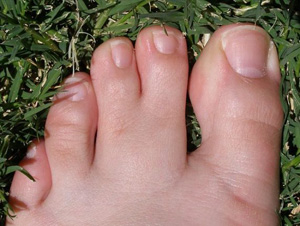
Syndactyly results in fingers and/or toes that are fused together
People with syndactyly have some or all of their fingers or toes fused together by tissue sometimes called “webbing.” Syndactyly is not typically painful but can affect the functioning of the hands or feet depending on the level of fusion.
Fingers and toes with syndactyly can be separated by a plastic surgeon or a hand surgeon.
Strabismus
Crossed eyes or strabismus is when of one or both eyes turn inward. Strabismus may happen to a person sometimes (intermittent) or be present all the time (constant).
Individuals with strabismus should see an ophthalmologist for treatment. Strabismus is first treated with a patch over the affected eye and or vision therapy. If those treatments do not work, surgery may be necessary.
